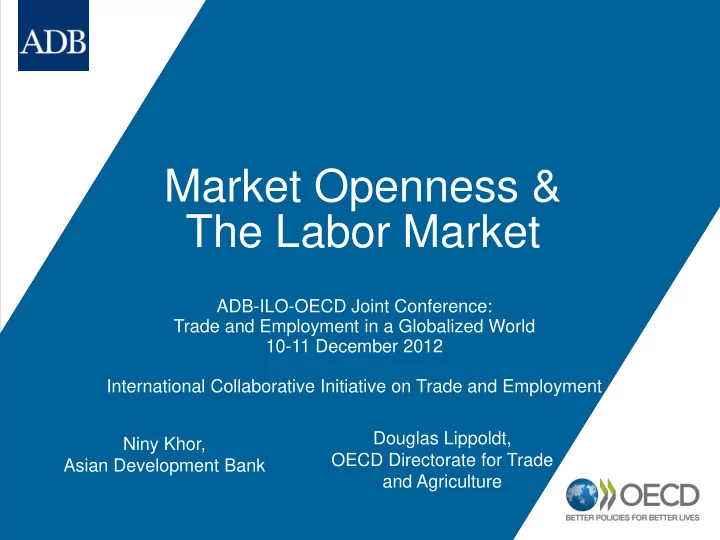

Market Openness & The Labor Market ADB-ILO-OECD Joint Conference: Trade and Employment in a Globalized World 10-11 December 2012 International Collaborative Initiative on Trade and Employment Douglas Lippoldt, Niny Khor, OECD Directorate for Trade Asian Development Bank and Agriculture
International Collaborative Initiative on Trade and Employment • ICITE is a collaborative effort of 10 international organisations • Active engagement of social partners • Empirical approach to the issues 2
Trade openness and growth, East Asia & Pacific Source: WDI. 3
Market Openness: Making It Effective • Opening at the border and liberalizing traditional trade measures such as tariffs: important • As tariffs reduced, binding constraints relate more to behind the border issues • OECD’s Market Openness Principles provide guidance on key issues related to making market openness effective 4
World Bank: Overall Trade Restrictiveness Index, applied tariffs-only, 2009 OTRI averages for agriculture and manufactured imports. Source: World Bank on-line, http://econ.worldbank.org 5
OECD Market Openness Principles • Principles of Market Openness: – Transparency – Non-discrimination – Use of least restrictive regulations – Harmonisation towards international standards – Streamlining conformity assessment – Application of competition principles from a market openness perspective Also related: – Respect for intellectual property rights
Case of Indonesia • The Indonesian economy is healthy… – GDP, inflation, unemployment and external balances are solid. – FDI has been robust. • Tariffs are low and tariff dispersion has fallen. • Important steps have been taken to improve the business environment, but barriers persist for mode 3 trade in services. • NTMs appear to be on the rise (e.g., licensing). Source: Lesher, M. (2012), Indonesia: Market Openness, OECD Reviews of Regulatory Reform. 7
OECD Market Openness Recommendations: Indonesia • Establish an independent body to evaluate the impact of trade and investment regulations. • Institute a process in which broad stakeholder consultations are systematically required. • Improve co-ordination between the centre and the periphery. • Ensure that new laws and regulations benefit Indonesia as a whole (e.g., RIAs). • Streamline the licensing process. Source: OECD (2012), OECD Reviews of Regulatory Reform: Indonesia. 8
Market Openness Yields Benefits for the Labour Market Source: Flanagan and Khor (2011) 9
Market Openness Yields Benefits for the Labour Market Table 4. Labor Conditions - Recent Developments 2008 Percent Change Since 1999 Working Conditions Asian Non-Asian Asian Non-Asian Hourly compensation 37.0 19.43 236.6 152.6 Annual Work Hours 2156 1914 2.3 .2 Job Accident Rate 5.9 n.a. -22.2 n.a. Labor Rights Asian Non-Asian Asian Non-Asian Child Labor Civil Liberties 4.5 2.0 -8.1 -22.3 Note: Labor force w eighted estimates. Sources: See Appendix A. Source: Flanagan and Khor (2011) 10
Main findings for Asia • Broad improvement in labor conditions in Asia and other countries accompanied globalization of late 20 th and early 21 st century • Advances in per capita GDP advance labor conditions, and main influence of increased trade flows on labor conditions is indirect through its impact on per capita GDP • Poor labor conditions do not attract disproportionate shares of world FDI. Market size and investment risk are the dominant influences on FDI Source: Flanagan and Khor (2011) 11
Trade and employment in Indonesia • Weak performance in creating manufacturing jobs partially due to fewer jobs in export- oriented industries after Asian financial crisis (Aswicahyono, Brooks and Manning 2011) • Number of jobs created per unit of export has also declined over time, implying low elasticities of employment with respect to exports • Higher value-added services sector is key 12
Indonesia labor market: informal work Percentage of Informal Workers to Total Employment Bangladesh 88.3 85.9 (1991-2005) India 80.1 81.9 (1991-2008) Nepal 74.3 71.6 (1991-2001) Indonesia 68.5 67.9 (1992-2008) Pakistan 74.2 63.1 (1990-2008) PRC 64.3 58.9 (1995-2008) Thailand 70.3 54.2 (1990-2008) Philippines 53.1 43.5 (1990-2008) Korea, Rep. of 32.6 Year 24.8 (1990-2008) Start End Malaysia 31.4 21.9 (1990-2008) Hong Kong, China 10.2 10.7 (1990-2008) Singapore 8.1 10.0 (1991-2008) 0 25 50 75 100 13 Source: ADB (2011)
Informality and non-wage benefits Source: ADB (2011) 14
Increasing % of employees working at least 40 hours per week Source: Flanagan and Khor (2011) 15
New ICITE book: Policy Priorities for International Trade and Jobs OECD Trade and Agriculture Directorate 16
For more information • ICITE publication and working papers available gratis at: www.oecd.org/trade/icite • OECD Trade and Agriculture Directorate: www.oecd.org/tad • Contact us : tad.contact@oecd.org , nkhor@adb.org • Follow us on Twitter: @OECDtrade 17
Recommend
More recommend